NASA Exercise: Survival on the Moon
ACTIVITY
Your Ranking NASA Ranking
_______ Box of matches _______
_______ Food concentrate _______
_______ 50 feet of nylon rope _______
_______ Parachute silk _______
_______ Portable heating unit _______
_______ Two .45 caliber pistols _______
_______ One case of dehydrated milk _______
_______ Two 100 lb. tanks of oxygen _______
_______ Stellar map _______
_______ Self-inflating life raft _______
_______ Magnetic compass _______
_______ 20 liters of water _______
_______ Signal flares _______
_______ First aid kit, including injection needle _______
_______ Solar-powered FM receiver-transmitter _______
Scoring:
For each item, mark the number of points that your score differs from the
NASA ranking, then add up all the points. Disregard plus or minus
differences. The lower the total, the better your score.
0 - 25 excellent
26 - 32 good
33 - 45 average
46 - 55 fair
56 - 70 poor -- suggests use of Earth-bound logic
71 - 112 very poor – you’re one of the casualties of the space program!
... published in the July 1999 issue of the NightTimes
Scenario:
You are a member of a space crew originally scheduled to rendezvous with a
mother ship on the lighted surface of the moon. However, due to mechanical
difficulties, your ship was forced to land at a spot some 200 miles from the
rendezvous point. During reentry and landing, much of the equipment aboard
was damaged and, since survival depends on reaching the mother ship, the
most critical items available must be chosen for the 200-mile trip. Below are
listed the 15 items left intact and undamaged after landing. Your task is to
rank order them in terms of their importance for your crew in allowing them
to reach the rendezvous point. Place the number 1 by the most important item,
the number 2 by the second most important, and so on through number 15 for
the least important.
_______ Box of matches _______
_______ Food concentrate _______
_______ 50 feet of nylon rope _______
_______ Parachute silk _______
_______ Portable heating unit _______
_______ Two .45 caliber pistols _______
_______ One case of dehydrated milk _______
_______ Two 100 lb. tanks of oxygen _______
_______ Stellar map _______
_______ Self-inflating life raft _______
_______ Magnetic compass _______
_______ 20 liters of water _______
_______ Signal flares _______
_______ First aid kit, including injection needle _______
_______ Solar-powered FM receiver-transmitter _______
Scoring:
For each item, mark the number of points that your score differs from the
NASA ranking, then add up all the points. Disregard plus or minus
differences. The lower the total, the better your score.
0 - 25 excellent
26 - 32 good
33 - 45 average
46 - 55 fair
56 - 70 poor -- suggests use of Earth-bound logic
71 - 112 very poor – you’re one of the casualties of the space program!
... published in the July 1999 issue of the NightTimes
POLYNOMIALS
Polynomials
A polynomial looks like this:
 |
| example of a polynomial this one has 3 terms |
Polynomial comes from poly- (meaning "many") and -nomial (in this case meaning "term") ... so it says "many terms"
A polynomial can have:
| constants (like 3, -20, or ½) |
| variables (like x and y) |
| exponents (like the 2 in y2), but only 0, 1, 2, 3, ... etc are allowed |
... except ...
| ... not division by a variable (so something like 2/x is right out) |
A polynomial can have constants, variables and exponents,
but never division by a variable.
but never division by a variable.
Polynomial or Not?
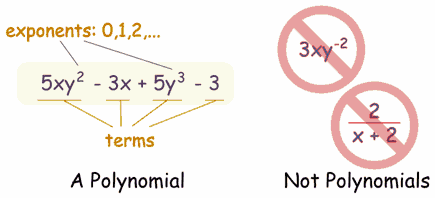
- 3x
- x - 2
- -6y2 - (7/9)x
- 3xyz + 3xy2z - 0,1xz - 200y + 0,5
- 512v5+ 99w5
- 5
And these are not polynomials
- 3xy-2 is not, because the exponent is "-2" (exponents can only be 0,1,2,...)
- 2/(x+2) is not, because dividing by a variable is not allowed
- 1/x is not either
- √x is not, because the exponent is "½"
- x/2 is allowed, because you can divide by a constant
- also 3x/8 for the same reason
- √2 is allowed, because it is a constant (= 1,4142...etc)
Monomial, Binomial, Trinomial
There are special names for polynomials with 1, 2 or 3 terms:
| How do you remember the names? Think cycles! |
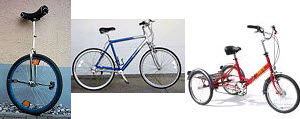 |
There is also quadrinomial (4 terms) and quintinomial (5 terms),
but those names are not often used.
but those names are not often used.
Can Have Lots and Lots of Terms
Polynomials can have as many terms as needed, but not an infinite number of terms.Variables
Polynomials can have no variable at all
Example: 21 is a polynomial. It has just one term, which is a constant.
Or one variable
Example: x4-2x2+x has three terms, but only one variable (x)
Or two or more variables
Example: xy4-5x2z has two terms, and three variables (x, y and z)
What is Special About Polynomials?
Because of the strict definition, polynomials are easy to work with.For example we know that:
- If you add polynomials you get a polynomial
- If you multiply polynomials you get a polynomial
Degree
The degree of a polynomial with only one variable is the largest exponent of that variable.Example:
| The Degree is 3 (the largest exponent of x) |
Standard Form
The Standard Form for writing a polynomial is to put the terms with the highest degree first.Example: Put this in Standard Form: 3x2 - 7 + 4x3 + x6
The highest degree is 6, so that goes first, then 3, 2 and then the constant last:
x6 + 4x3 + 3x2 - 7
POLYNOMIALS OPERATIONS
Reading Fractions
Slice a pizza, and we get fractions:
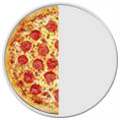 | 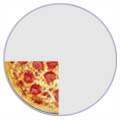 | 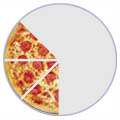 |
| 1/2 | 1/4 | 3/8 |
(One-Half)
|
(One-Quarter)
|
(Three-Eighths)
|
The top number says how many slices we have.
The bottom number says how many equal slices the whole pizza was cut into.
The bottom number says how many equal slices the whole pizza was cut into.
Some fractions may look different, but are really the same, for example:
| 4/8 | = | 2/4 | = | 1/2 |
| (Four-Eighths) | (Two-Quarters) | (One-Half) | ||
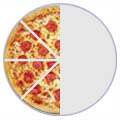 | = | 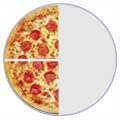 | = |  |
It is usually best to show an answer using the simplest fraction ( 1/2 in this case ). That is calledSimplifying, or Reducing the Fraction
Numerator / Denominator
We call the top number the Numerator, it is the number of parts we have.
We call the bottom number the Denominator, it is the number of parts the whole is divided into.
We call the bottom number the Denominator, it is the number of parts the whole is divided into.
NumeratorDenominator
You just have to remember those names! (If you forget just think "Down"-ominator)
Adding Fractions
It is easy to add fractions with the same denominator (same bottom number):
| 1/4 | + | 1/4 | = | 2/4 | = | 1/2 |
| (One-Quarter) | (One-Quarter) | (Two-Quarters) | (One-Half) | |||
 | + |  | = |  | = |  |
Another example:
| 5/8 | + | 1/8 | = | 6/8 | = | 3/4 |
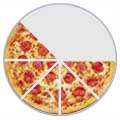 | + | 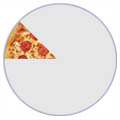 | = | 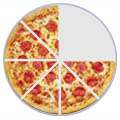 | = | 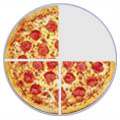 |
Adding Fractions with Different Denominators
But what about when the denominators (the bottom numbers) are not the same?
| 3/8 | + | 1/4 | = | ? |
 | + |  | = |  |
We must somehow make the denominators the same.
In this case it is easy, because we know that 1/4 is the same as 2/8 :
| 3/8 | + | 2/8 | = | 5/8 |
 | + | 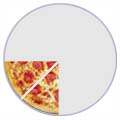 | = |  |
Solving math word problems
Addition
add(ed) to
all together
both
combined
in all
increase by
more than
perimeter
plus
sum
total
|
Subtraction
decreased by
difference
fewer than
how many more
left
less
less than
minus
remaining
take away
|
Multiplication
a
area
multiplied by
of
per
product of
rate
times
triple
twice
|
Division
divided
half
how many each
out of
percent
quarter
quotient of
percent
|
Solving math word problems
There are two steps to solving math word problems:
- Translate the wording into a numeric equation
that combines smaller "expressions" - Solve the equation!
Suggestions:
- Read the problem entirely
Get a feel for the whole problem - List information and the variables you identify
Attach units of measure to the variables (gallons, miles, inches, etc.) - Define what answer you need,
as well as its units of measure - Work in an organized manner
Working clearly will help you think clearly- Draw and label all graphs and pictures clearly
- Note or explain each step of your process;
this will help you track variables and remember their meanings
- Look for the "key" words (above)
Certain words indicate certain mathematical operations:
Math expressions (examples):
after you review the keywords, test yourself
after you review the keywords, test yourself
| addition: 5+x | subtraction: 5-x |
| multiplication: 5*x; 5x | division: 5 ÷ x; 5/x |
| Exercise: ("mouse over" the block for answer) | |
| Key words for addition + increased by; more than; combined together; total of; sum; added to | |
What is the sum of 8 and y?
| 8 + y |
Express the number (x) of apples
increased by two | x + 2 |
Express the total weight of
Alphie the dog (x) and Cyrus the cat (y) | x + y |
| Key words for Subtraction - less than, fewer than, reduced by, decreased by, difference of | |
What is four less than y
| y - 4 |
What is nine less than a number (y)
| y - 9 |
What if the number (x) of pizzas
was reduced by 6? | x - 6 |
What is the difference of my weight (x)
and your weight (y) | x - y |
| Key words for multiplication * x or integers next to each other (5y, xy):of, times, multiplied by | |
What is y multiplied by 13
| 13y or 13 * y |
Three runners averaged "y" minutes.
Express their total running time: | 3y |
I drive my car at 55 miles per hour.
How far will I go in "x" hours? | 55x |
| Key words for division ÷ / per, a; out of; ratio of, quotient of; percent (divide by 100) | |
What is the quotient of y and 3
| y/3 or y ÷ 3 |
Three students rent an apartment
for $ "x" /month. What will each have to pay? | x/3 or x ÷ 3 |
"y" items cost a total of $25.00.
Express their average cost: | 25/y or 25 ÷ y |
More vocabulary and key words:
- "Per" means "divided by"
as "I drove 90 miles on three gallons of gas, so I got 30 miles per gallon."
(Also 30 miles/gallon) - "a" sometimes means "divided by"
as in "When I filled up, I paid $10.50 for three gallons of gasoline,
so the gas was 3.50 a gallon, or $3.50/gallon - "less than"
If you need to translate "1.5 less than x", the temptation is to write "1.5 - x". DON'T! Put a "real world" situation in, and you'll see how this is wrong: "He makes $1.50 an hour less than me." You do NOT figure his wage by subtracting your wage from $1.50.
Instead, you subtract $1.50 from your wage - "quotient/ratio of" constructions
If a problems says "the ratio of x and y",
it means "x divided by y" or x/y or x ÷ y - "difference between/of" constructions
If the problem says "the difference of x and y",
it means "x - y"
What if the number (x) of children was reduced by six, and then they had to share twenty dollars? How much would each get?
| 20/(x - 6) |
What is 9 more than y?
| y + 9 |
What is the ratio of 9 more than y to y?
| (y + 9)/y |
What is nine less than the
total of a number (y) and two | (y + 2) - 9 or y - 7 |
The length of a football field is 30 yards more than its width "y". Express the length of the field in terms of its width y
| y + 30 |
DECIMALS - 1ºESO
1. Candy is on sale 5 pounds for $9.95. Find the
price per unit.
- $10.00
- $5.02
- $1.99
- $0.50
2. If candy is $4.25 per pound, how much would 3
pounds cost?
- $12.75
- $0.71
- $1.28
- $1.42
3. Ruby has $10. She buys a bottle of water for
$1.29 and a bracelet for $5.95. How much change will she get back at
the register?
- $2.76
- $7.24
- $3.24
- no change
4. At a clothing store, T-shirts are on sale for
$9.97 each. What is the cost for 3 shirts?
- $29.91
- $27.91
- $3.32
- $12.9
5. Find the sum of 34.2 and 5.374.
- 39.574
- 28.826
- 5.716
- 185.7908
6. The student council bought 7 bags of apples for
their fall party. Bags of apples were on sale for $3.45 each. How
much did they pay for the apples?
- $24.15
- $0.49
- $23.85
- None of the above
7. One of the first helicopters flew at a speed of
44.7 km per hour. At this speed, ABOUT how far could the helicopter
travel in 2.75 hours?
- A little more than 135 km.
- Exactly 135 km.
- 47.45 km
- A little less than 135 km.
8. A muffin recipe calls for 0.75 cups of
blueberries. Paul is making 5 batches. He already has 2.5 cups of
blueberries. How many more cups does he need?
- 1 1/2 cups
- 3.25 cups
- 3.75 cups
- 1.25 cups
Agentes geológicos externos.
http://recursos-itaca.blogspot.com/2016/02/agentes-geologicos-externos.html
Los agentes geológicos externos (atmósfera, hielo, aguas superficiales, aguas subterráneas y seres vivos) modifican el relieve y el paisaje mediante procesos de meteorización, erosión, transporte y sedimentación.
El viento arrastra partículas en suspensión y modela el relieve. Los glaciares se desplazan lentamente por la superficie terrestre. Los ríos erosionan, transportan materiales y los depositan en sus desembocaduras. Las aguas subterráneas se almacenan formando acuíferos. Las aguas marinas ejercen mediante las olas, mares y corrientes una triple acción: erosión, transporte y sedimentación que dan lugar a estructuras características en las zonas costeras.
La Tierra se modela por la acción de los agentes geológicos externos. El agua, en sus diferentes formas, y el viento, transforman el paisaje.
El agua cuando cae en forma de precipitaciones arrastra materiales, ya sea cuando discurre en forma de aguas de arroyada, torrentes o formando ríos. Si se infiltra en el terreno forma acuíferos, si los materiales lo permiten.
Cuando las rocas son solubles, el agua las disuelve y forma estructuras espectaculares.
Si la temperatura es muy baja, el agua forma glaciares que avanzan lentamente por los valles.
El agua de los mares y océanos va esculpiendo las costas, proporcionándonos agradables playas e impresionantes acantilados.
El viento actúa sobre las regiones áridas del planeta, que no tienen una cubierta vegetal que les proteja de su acción. Las rocas adquieren formas fabulosas y aparecen mares de arena que avanzan poco a poco.
Subscribe to:
Posts (Atom)








